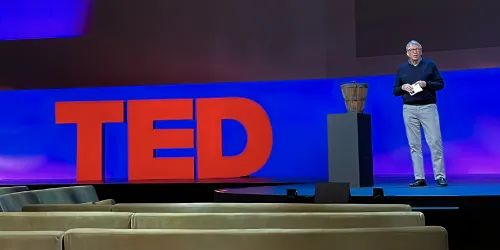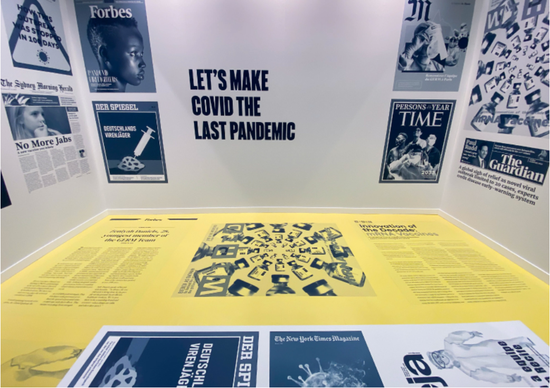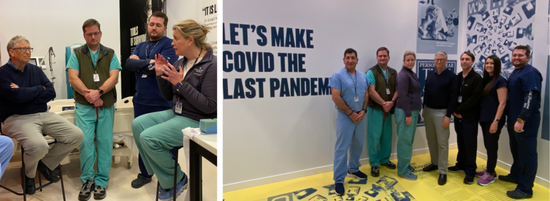比尔·盖茨:在TED谈论最后一次大流行

来源:比尔盖茨
Last week, I went to the TED conference in Vancouver. It was my first time back at TED since 2015, when I gave a speech about how the world wasn’t ready for the next epidemic.
上周,我参加了在温哥华举行的TED大会。这是我自2015年后再次回到TED,当年我发表了有关世界怎么没有为下一场流行病做好准备的演讲。
A lot of people watched that talk, but almost all of the views came after the start of the COVID-19 pandemic. This time, I spoke about the same subject, but a lot had changed. No one in the audience needed to be convinced that a deadly virus could kill millions of people around the world and upend our lives.
很多人观看了2015年的那场演讲,但几乎所有的浏览量都是在新冠大流行暴发后才产生的。这一次,我谈到了同样的话题,但很多事情都已改变。观众都已明白,有一种致命的病毒会杀死全世界数百万人并颠覆我们的生活。
My talk was all about how we can make COVID-19 the last pandemic. I believe we can eliminate the threat of pandemics completely if we approach infectious diseases like we approach fires. We need a well-oiled system in place, complete with full-time professional personnel and innovative tools ready to be deployed at a moment’s notice.
我的演讲是关于如何使新冠疫情成为最后一次大流行。我相信,如果我们像对待火灾一样对待传染病,我们完全可以消除大流行病的威胁。我们需要一个运转完善的系统,配备随时可以部署的全职专业人员和创新工具。
You can watch my full talk here:
下面是演讲的完整视频:
在TED做演讲是令人难忘(也令人极度紧张!)的经历。几个月前,我就开始思考想谈些什么。我决定聚焦于全球流行病应对和动员(GERM)团队,这是一个由全职付薪人员组成的新团队,其全部工作是为下一次疫情暴发做准备。我在即将出版的书中写了很多关于GERM的内容,但这是我第一次在公开演讲中详细谈论GERM。
One of the coolest things about TED is how visual all the talks are. I had the opportunity to make sure the graphics for mine looked okay during a rehearsal. I also got to practice bringing the Roman fire brigade bucket I was using as a prop onto the stage. (It’s a lot heavier than it looks!)
TED最酷的一点是所有演讲的视觉效果。在排练中,我有机会确保图表的呈现效果。我还练习了将用作道具的古罗马消防桶搬上舞台。(它比看起来重得多!)

On the morning of my talk, I made sure to find some quiet time backstage to review my notes. I believe that this moment in time—two-plus years into the pandemic, as COVID slowly becomes endemic and the acute phase comes to an end—is a crucial one for pandemic prevention. We need to convince the world to get ready for another pandemic while COVID-19 is still fresh in everyone’s minds.
演讲的那天早上,我抽空在后台复习了演讲内容。我相信此时此刻——大流行已经持续了两年多,随着新冠肺炎慢慢成为地方病并且急性期将要结束——对于大流行的防范至关重要。趁着新冠肺炎在每个人的脑海中仍然印象深刻,我们需要说服世界为另一次大流行做好准备。

When the time came to give the actual talk, I was ready and excited to speak about GERM. There’s currently no full-time international team of experts standing by to respond to an outbreak as soon as one emerges. If we’re going to prevent the next pandemic, the world needs the infectious disease equivalent of firefighters—a group of in-country and global epidemiologists, data scientists, logistics experts, and more who are ready to go anywhere in the world on a moment’s notice.
要上台时,我已准备好并为即将谈论GERM而感到兴奋。目前尚没有一个全职的国际专家团队可以随时待命,应对疫情的暴发。如果我们要预防下一次大流行,世界需要一个应对传染病的消防队——一群国内和全球的流行病学家、数据科学家、物流专家等,他们随时准备前往世界上任何地方。

We also put on an exhibit at TED called “The Last Pandemic.” The concept was simple: What if you could visit a museum exhibit about the last pandemic the world ever faced—COVID-19—fifty years in the future? What memories and artifacts from the last two years would be in it? And what would it reveal about how we created a world free from the threat of pandemics?
我们还在TED举办了一场名为“最后一次大流行”的展览。这个展的概念很简单:五十年后,要是你来博物馆观看关于世界上最后一次大流行——新冠肺炎大流行——的展览,你会看到什么?过去两年中发生的什么样的记忆和物品会在展览中出现??以及,它将怎样揭示我们如何来创造一个没有大流行威胁的世界?

Each room featured a different theme, like the tools we used to stop COVID or maps that showed how quickly the virus spread around the world. As you walked through the exhibit, you moved forward in time and eventually ended up in a room filled with newspaper and magazine headlines from a world without pandemics. It was inspiring to imagine a future where no one has to live in fear of another COVID-19.
每个展区都有不同的主题,比如我们用来阻止新冠病毒的工具或显示病毒在世界范围内传播速度的地图。展览的最后,你会走入一个房间,里面都是来自没有大流行病的世界的报纸和杂志头条。想象一下——没有人生活在对另一场新冠疫情的恐惧中——这样的未来是令人鼓舞的。

My favorite part was the room about life on the frontlines, which featured six healthcare workers from across the U.S. who were eager to share their stories. Their experiences were varied. Joe Gorga, an ICU pulmonologist who worked at one of the first hospitals in New York City to get hit hard, showed me a photo of his mentor, who died from COVID in April 2020. Kristin Dascomb, an infectious disease doctor from Utah, not only treated patients but also worked on ways to keep her fellow healthcare workers safe. Nathan Starr, a hospitalist, told me how he helped set up Hospital at Home, a program that treated more than 700 people. Brad Thorup, a trauma nurse, shared how frustrated he was when he saw how many of the people admitted to his unit were unvaccinated. Gustavo Vargas and Jessica Green, who are both nurse anesthetists, told me about how challenging and scary it was to intubate people in the early days before they had the right PPE.
我最喜欢的是医护人员一线生活的展区,里面呈现了来自美国各地的六名医护人员的故事。他们渴望分享,而他们的经历则多种多样。乔·戈尔加(Joe Gorga)是一位ICU的肺科医生,他曾在纽约市首批遭受重创的医院里工作,他曾给我看过他导师的照片,他的导师在2020年4月死于新冠肺炎。来自犹他州的传染病医生克里斯汀·达斯康姆(Kristin Dascomb)不仅治疗患者,也致力于确保身边医护人员的安全。住院医师内森·斯塔尔(Nathan Starr)告诉我他是如何帮助建立居家医院项目(Hospital at Home)的,该项目治疗了700多人。创伤护士布拉德·索鲁普 (Brad Thorup) 分享了当他看到大量患者没有接种疫苗而入院治疗时的沮丧情绪。麻醉护士古斯塔沃·瓦尔加斯(Gustavo Vargas)和杰西卡·格林(Jessica Green)告诉我,在他们拥有完善的个人防护装备(PPE)之前,对患者进行插管时内心充满恐惧,并感到极大的挑战。
I got pretty emotional listening to them talk about their experiences. I later learned that many of the people who visited the exhibit cried when they spoke to the healthcare workers, and I understand why. Each of them is a true hero. I was honored to get to thank them firsthand for all they have done to save lives. (If you’re interested in hearing stories like theirs, The Nocturnists’ “Stories from a Pandemic” podcast is terrific.)
听他们谈论这些经历时,我的情绪非常激动。后来我了解到,许多参观展览的人在与医护人员交谈时都哭了,我理解这背后的原因。每一位医护人员都是真正的英雄。我很荣幸能够亲自感谢他们为拯救生命所做的一切。(如果你有兴趣听听像他们这样的故事,博客平台夜行者(The Nocturnists)的“大流行故事”系列非常棒。)

It was great to see so many people visit “The Last Pandemic.” I even had the opportunity to catch up with several of the Gates Foundation’s Goalkeepers—Farwiza Farhan, Kathryn Finney, and Boniface Mwangi—when they stopped by. I loved getting to hear about their latest work to make the world a healthier and more equitable place.
很高兴看到这么多人参观“最后一次大流行”展。我还有机会见到了盖茨基金会的几位目标守卫者——法维扎·法尔汉(Farwiza Farhan)、凯瑟琳·芬尼(Kathryn Finney)和博尼法斯·姆旺吉(Boniface Mwangi)。交谈中,我很高兴听到他们最近的工作让世界变得更健康、更公平。

I’m planning to spend a lot of time talking about how we can make COVID the last pandemic in the weeks and months ahead, because I believe this is one of the most important issues facing the world today. Even when we’re not facing an active outbreak, investments in pandemic prevention will save lives and shrink the health gap between the rich and the poor. This is an opportunity to not just stop things from getting worse but to make them so much better.
我计划在未来几周和几个月里花很多时间谈论我们如何才能使新冠肺炎成为最后一次大流行,因为我相信这是当今世界面临的最重要问题之一。即使我们不再面对一场活跃的疫情暴发,对预防大流行的投资也将挽救生命并弥合贫富之间的健康差距。这是一个机会,我们不仅可以阻止事态恶化,还能让事情变得更好。
比尔盖茨拓展阅读
热门文章
- 茶叶如何保存?快来看容声厅吧的存储小妙招
2022-04-28 13:22 - 海西:浙江援青项目集中开工建设
2022-04-24 13:18 - 5G催化物联网应用加速落地 AIoT+金融迎新机遇
2022-04-22 19:21 - 每年投入不少于1000万元 灞桥区全力推进秦创原建设
2022-04-23 07:19 - AMD Zen4处理器曝光:老用户最担心的事情还是来了
2022-04-28 13:23 - 蔚来第1000座换电站在拉萨正式投入运营
2022-07-06 18:03
推荐阅读








